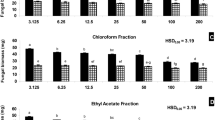Abstract
THE recent discovery1,2 that synthetic plant-growth substances such as 2 : 4-dichlorophen-oxyacetic acid have selective phytoeidal actions in very low concentrations has opened up a new field of investigation into their mechanisms of action. The search for new molecules with similar properties has been intensified. The fact that unsaturated lactone groupings are frequent features of naturally occurring substances having inhibitive effects on cell-growth3,4,5 revives interest in the phytocidal activity of the common plant metabolite, coumarin. This substance was, apparently, first shown by Klebs6 to be toxic to Algæ, and later by Schreiner, Reed and Skinner7 to have inhibitive effects on the growth of wheat. Cameron8, in a discussion on soil fertility, referred to the fact that both coumarin and daphnetin prevented the development of wheat, and Sigmund9 noted the effects of daphnetin and æsculetin on seed germination. In 1934, Köckemann10 gave the term 'blasto-choline' to material of unknown structure, present in ripe fruits, which suppressed germination of cress seeds. Since then it has been shown11.12,13 that a number of unsaturated lactones, including coumarin, parasorbic acid and B-angelicalactone have blastocholine effects, suppressing germination of seeds at concentrations such as 100 parts per million. The concentrations at which the lactones are effective have been considered to be much higher than those which bring about comparable effects with 2 : 4-dichlorophenoxyacetic acid.
This is a preview of subscription content, access via your institution
Access options
Subscribe to this journal
Receive 51 print issues and online access
$199.00 per year
only $3.90 per issue
Buy this article
- Purchase on Springer Link
- Instant access to full article PDF
Prices may be subject to local taxes which are calculated during checkout
Similar content being viewed by others
References
Nutman, Thornton and Quastel, Nature, 155, 498 (1945).
Slade, Templeman and Sexton, Nature, 155, 497 (1945).
Langer, Martin and Muller, Helv. Chim. Acta, 27, 892 (1944).
Medawar, Robinson and Robinson, Nature, 151, 195 (1943).
Veldstra, Enzymologia, 11, 373 (1944).
Klebs, "Die Bedingungen der Fortpflanzung bei einigen Algen und Pilzen" (Jena, 1896).
Shreiner, Reed and Skinner, U.S. Dept. Agric. Bur. Soils, Bull. 47 (1907).
Cameron, J. Phys. Chem., 14, 422 (1910).
Sigmund, Biochem. Z., 62, 339 (1914).
Köckemann, Ber. Deut. Bot. Ges., 52, 523 (1934).
Haynes and Jones, J. Chem. Soc., 954 (1946).
Kuhn, Jerchel, Moewus, Müller and Lettré, Naturwiss., 31, 468 (1943).
Veldstra and Havinga, Rec. Trav. Chim., 62, 841 (1943).
Audus, Nature, 158, 419 (1946).
Author information
Authors and Affiliations
Rights and permissions
About this article
Cite this article
AUDUS, L., QUASTEL, J. COUMARIN AS A SELECTIVE PHYTOCIDAL AGENT. Nature 159, 320–324 (1947). https://doi.org/10.1038/159320a0
Issue Date:
DOI: https://doi.org/10.1038/159320a0
This article is cited by
-
Microbial decomposition of coumarin in soil
Folia Microbiologica (1974)
-
The effects of coumarin on the growth and viability of sporelings of red algae
Planta (1967)
-
Untersuchungen über die Wirkung einiger 1,2,4-Triazolderivate auf das Wachstum der Keimlinge vonSinapis alb a L.
Biologia Plantarum (1961)
-
Differential growth-inhibitors produced by plants
The Botanical Review (1961)
-
Wirkungen von Cumarin auf Wachstums-und Entwicklungsvorgänge und seine Wanderungsfähigkeit im Pflanzengewebe
Planta (1960)
Comments
By submitting a comment you agree to abide by our Terms and Community Guidelines. If you find something abusive or that does not comply with our terms or guidelines please flag it as inappropriate.



